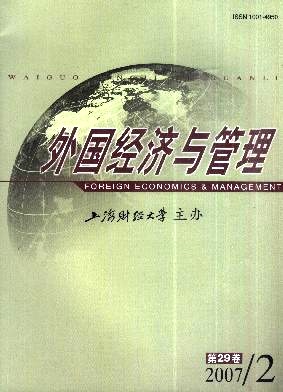基于个体决策视角的投票出席率实验研究述评
外国经济与管理 2007 年 第 29 卷第 02 期, 页码:39 - 44
摘要
参考文献
摘要
“投票悖论(voting paradox)”与“不投票悖论(paradox of not voting)”问题构成了目前投票行为实验研究的边界,而核心问题则是投票出席率。本文从团体内与团体间冲突、投票人之间的信息交流、投票时序、投票人偏好关联类型以及投票成本对投票出席率的影响几个方面对国外相关实验研究文献进行了有选择的梳理和简单评述。
[1]Downs,A.An economic theory of democracy[M].New York:Harper and Row,1957.
[2]Palfrey,T,and H Rosenthal.A strategic calculus of voting[J].Public Choice,1983,41:7-53.
[3]Palfrey,T,and H Rosenthal.Voter participation and strategic uncertainty[J].American Political Science Review,1985,79:62-78.
[4]Schram,A,and F van Winden.Why people vote:Free riding and the production and consumption of social pressure[J].Journal of E-conomic Psychology,1991,12:575-620.
[5]Schram,A.Voter behavior in economic perspective[M].Heidelberg:Springer-Verlag,1991.
[6]Kramer,R M,and M B Brewer.Effects of group identity on resource use in a simulated commons dilemma[J].Journal of Personalityand Social Psychology,1984,46:1044-1057.
[7]Bornstein,G.The free-rider problem in inter-group conflicts over step-level and continuous public goods[J].Journal of Personalityand Social Psychology,1992,62(4):597-606.
[8]Schram,A,and J Sonnemans.Why people vote:Experimental evidence[J].Journal of Economic Psychology,1996,17:417-442.
[9]Groβer,J,and A Schram.Neighborhood information exchange and voter participation:An experimental study[J].American PoliticalScience Review,2006,100(2):235-248.
[10]Borgers,T.Costly voting[J].American Economic Review,2004,94,57-66.
[11]Levine,D K,and T Palfrey.The paradox of voter participation:A laboratory study[R].Working Paper,2005a,UCLA and Prin-ceton University,Downloadable:http://levine.sscnet.ucla.edu/papers.htm.
[12]Battaglini,M,Morton,R,and Palfrey,T.Efficiency,equity and timing in voting mechanisms[R].CEPR Discussion Papers,2005,No.5291,Downloadable:http://www.cepr.org/pubs/dps/DP5291,asp.
[13]Feddersen,J,and W Pesendorfer.The swing voter’s curse[J].American Economic Review,1996,86(3):408-424.
[14]Battaglini,M,Morton,R,and Palfrey,T.The swing voter’s curse in the laboratory[R].CEPR Discussion Papers,2005b,No.5458,Downloadable:http://www.cepr.org/pubs/dps/DP5458,asp.
[15]Brown,C E.A false consensus bias in 1980 presidential preferences[J].The Journal of Social Psychology,1982,118:137-138.
[16]Dawes,R M.The potential non-falsity of the false consensus effect[A].in R M Hogarth(Ed.).Insights in decision making:Atribute to Hillel T Einhorn[C].Chicago:University of Chicago Press,1990:97-110.
[17]Engelmann,D,and M Strobel.The false consensus effect disappears if representative information and monetary incentives are given[J].Experimental Economics,2000,3:241-260.
[2]Palfrey,T,and H Rosenthal.A strategic calculus of voting[J].Public Choice,1983,41:7-53.
[3]Palfrey,T,and H Rosenthal.Voter participation and strategic uncertainty[J].American Political Science Review,1985,79:62-78.
[4]Schram,A,and F van Winden.Why people vote:Free riding and the production and consumption of social pressure[J].Journal of E-conomic Psychology,1991,12:575-620.
[5]Schram,A.Voter behavior in economic perspective[M].Heidelberg:Springer-Verlag,1991.
[6]Kramer,R M,and M B Brewer.Effects of group identity on resource use in a simulated commons dilemma[J].Journal of Personalityand Social Psychology,1984,46:1044-1057.
[7]Bornstein,G.The free-rider problem in inter-group conflicts over step-level and continuous public goods[J].Journal of Personalityand Social Psychology,1992,62(4):597-606.
[8]Schram,A,and J Sonnemans.Why people vote:Experimental evidence[J].Journal of Economic Psychology,1996,17:417-442.
[9]Groβer,J,and A Schram.Neighborhood information exchange and voter participation:An experimental study[J].American PoliticalScience Review,2006,100(2):235-248.
[10]Borgers,T.Costly voting[J].American Economic Review,2004,94,57-66.
[11]Levine,D K,and T Palfrey.The paradox of voter participation:A laboratory study[R].Working Paper,2005a,UCLA and Prin-ceton University,Downloadable:http://levine.sscnet.ucla.edu/papers.htm.
[12]Battaglini,M,Morton,R,and Palfrey,T.Efficiency,equity and timing in voting mechanisms[R].CEPR Discussion Papers,2005,No.5291,Downloadable:http://www.cepr.org/pubs/dps/DP5291,asp.
[13]Feddersen,J,and W Pesendorfer.The swing voter’s curse[J].American Economic Review,1996,86(3):408-424.
[14]Battaglini,M,Morton,R,and Palfrey,T.The swing voter’s curse in the laboratory[R].CEPR Discussion Papers,2005b,No.5458,Downloadable:http://www.cepr.org/pubs/dps/DP5458,asp.
[15]Brown,C E.A false consensus bias in 1980 presidential preferences[J].The Journal of Social Psychology,1982,118:137-138.
[16]Dawes,R M.The potential non-falsity of the false consensus effect[A].in R M Hogarth(Ed.).Insights in decision making:Atribute to Hillel T Einhorn[C].Chicago:University of Chicago Press,1990:97-110.
[17]Engelmann,D,and M Strobel.The false consensus effect disappears if representative information and monetary incentives are given[J].Experimental Economics,2000,3:241-260.
引用本文
宗计川. 基于个体决策视角的投票出席率实验研究述评[J]. 外国经济与管理, 2007, 29(2): 39–44.
导出参考文献,格式为:
下一篇:家族企业代际传承理论研究前沿动态





 6531
6531  324
324

